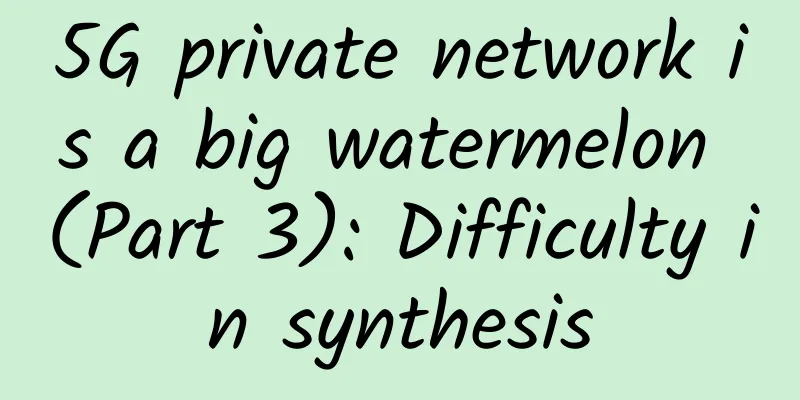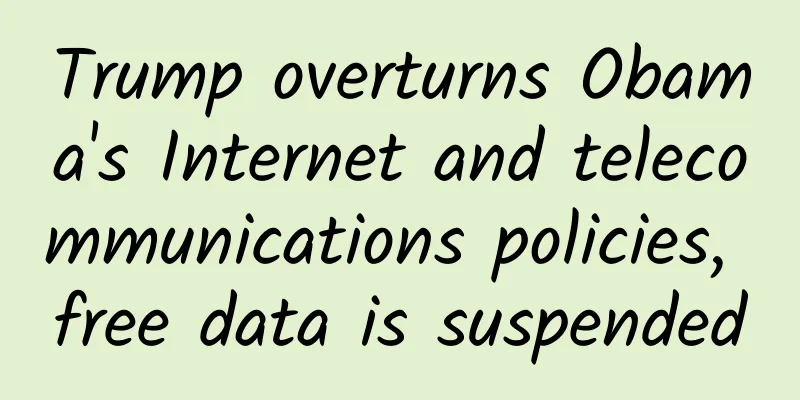5G private network is a big watermelon (Part 3): Difficulty in synthesis

|
To some extent, 5G private network does not allow all walks of life to "overtake on a curve", but directly gives them a "lane change". Whoever drives on this "new highway" first can usher in a new future of lane change development faster. I believe that through the first two articles in the series "5G Private Network is a Big Watermelon: The Question of Value" and "5G Private Network is a Big Watermelon (Part 2): The Mystery of Collision", everyone will more or less find 5G private network interesting. But it is more complicated to understand its rules of the game. On the one hand, the participants in the 5G private network market are no longer just operators and equipment manufacturers, but also AI manufacturers, chip manufacturers, cloud service companies, Internet companies, etc. Sylvain Fabre, senior research director of the global research institution Gartner, has also publicly said that "these networks (5G private networks) can be provided not only by CSPs (commercial service providers), but also directly by infrastructure suppliers; not only traditional large infrastructure suppliers, but also suppliers with cloud and software backgrounds." It is not easy to sort out the interests between them;
At the same time, 5G private networks involve complex technical systems and network reconstruction. We know that China's three major telecommunications operators have already launched their own private network solutions, platforms and development paths in cooperation with many science and technology companies. In addition to the communication technology itself, we often hear dazzling technical terms such as software-defined networking (SDN), network function virtualization (NFV), artificial intelligence (AI), cloud computing, mobile edge computing (MEC), etc. I think no logical chain is more suitable for understanding the industry rules of 5G private networks than "technology". Why has 5G private network unprecedentedly produced in-depth and extensive synergy with other technology systems? How does their mutual integration affect the entire industry chain? Answering these questions may hold the key to the success of 5G. 5G Private Network's "Technology Platter" You work hard to pick oranges and lemons, moving from the "fruit platter" to the watermelon; over there, 5G is also working hard to attract AI, cloud computing, chips and other players in the private network market to join in the celebration, creating a special "technology platter". This is probably the reality of the world that "no one can succeed easily". Why can't operators build "5G private networks" alone, but must turn it into a colorful "puzzle game" like synthesizing a big watermelon? It all probably starts with virtualization. As we mentioned in the previous article, most of my country's current 5G private networks are implemented in the form of virtual private networks. The reason is very simple. Spectrum resources are limited, and the number of industries eager to access private networks is increasing. To resolve the contradiction of "too many people and too little porridge", the most direct way is to borrow some resources from the public network next door. Although the public network can be very "generous" in sharing spectrum, the requirements of users on both sides are very different. Public network users require fast, accurate and stable, which is equivalent to uniformly distributing standard lunch boxes and leaving after taking them; private network users want chicken and fish, and they have to check one by one to ensure "food safety". If they are mixed together to queue up for food, no one can expect to eat well. The best solution at this time is to open a channel specifically for private network users so that they do not interfere with public network users, which is called "virtual private network". However, private network users have put forward several additional requirements:
According to traditional thinking, each private network user naturally builds an independent physical 5G private network. However, this is too costly, and it is more economical to queue up in the public network "canteen" instead of "opening a small kitchen". Since there is no way to physically isolate them, we can only draw several virtual areas to accommodate public network users and private network users from different industries. However, relying on the original equipment and technology obviously cannot meet the new requirements of 5G private networks. Therefore, some new technologies have emerged. In the "technical platter" of 5G private networks, these new technologies also bear their own important missions. For example, slicing technology is very much like the "grape" in the "synthetic watermelon" that likes to stand between two identical fruits to prevent them from mixing with each other. Network slicing: Private and public networks should be neat and tidy The two fruits were about to touch each other, but a grape fell from the sky and got sandwiched in between, preventing either from touching the other. The ability to divert data and isolate them securely is the strength of network slicing technology, which can isolate the ever-changing vertical industry applications from ordinary users of the public network, and divide them into multiple independent logical private networks, in which the services of private network users operate independently and the data is kept locally. At the same time, the virtual network reconstructed by network slicing (grape) can configure and schedule network resources through unified management and orchestration based on the needs of application scenarios, and flexibly deploy network functions, computing resources, storage resources, etc., thereby achieving highly customized and personalized effects. For example, new media parks and industrial parks have different requirements for network latency, speed, number of connections, etc., so you only need to make differentiated adjustments to bandwidth, services, etc. according to business needs. Even for the same business scenario, such as driverless cars on the road, different network slices are needed to achieve the optimal solution for network resource application: the large bandwidth of high-definition map navigation requires eMBB slices, the high-reliability and low-latency communication of autonomous driving requires uRLLC slices, and in-vehicle IoT applications require mMTC slices. With the network slicing technology, it is equivalent to forming independent network zones in the 5G private network space. You can put whatever fruits you want in the zone, instead of having to buy a new mobile phone for every additional customer. This is obviously the best choice for operators. Of course, readers who have played the game "Synthetic Watermelon" may know that it is not easy to control the grapes. No one knows where they will roll to or what accidents they will cause in the next second. Yes, to make good use of network slicing and make it work stably and reliably, operators also need to overcome the derivative problems brought about by this technology:
Efficiency, cost, and collaboration, aren’t these exactly what artificial intelligence is good at? Therefore, the "fruit platter" of 5G private networks has welcomed a new species - AI. Artificial Intelligence: A Helpful Helper We all know that AI has natural advantages in solving high-throughput computing data analysis, cross-domain feature mining, dynamic strategy generation, etc., and using it to do things like network resource deployment, operation and maintenance efficiency optimization, and operating cost control is like "AI handing over a pillow as soon as 5G falls asleep." In the existing 5G private network solutions, AI plays two main roles: 1. Full life cycle management of network slices. AI can be involved in the entire process from slicing the private network to activation, security, operation and maintenance, and achieve a balance between slicing flexibility and management complexity through intelligent perception, analysis, judgment and decision-making capabilities. For example, regarding the “how to slice” mentioned earlier, AI machine learning can be used at the very beginning to deeply explore the business specificities of private network users, integrate the available resources of the entire network, and use relevant algorithms to effectively judge the customer’s network needs, implement the most cost-effective network construction plan, and create a customized sliced private network to avoid subsequent duplication of construction and loss. "How to orchestrate after slicing", the trained AI algorithm model can intelligently orchestrate and schedule virtualized resources, automatically output models such as policy rules and slice optimization deployment, and then automatically disassemble the configuration parameters into each subnet to complete service activation. In the process of private network services, with the help of AI intelligent analysis and decision-making, dynamic evaluation can also be carried out in real time based on business data, network data, user information, etc., based on time, location, business type, user communication habits, number of connections, etc., to form the best matching control parameters, and continuously make the best decisions and controls. In the event of extreme situations or network congestion and other failures, early warnings or termination of services, and traffic speed-up and other response methods can also be used to maximize the availability and reliability of the private network. As for "multi-slice collaboration", AI's intelligent scheduling capabilities can automatically analyze based on time, location, mobility and other characteristics, combined with real-time network characteristics, output dynamic management strategies, and perform capacity optimization, configuration optimization, resource scaling, problem location and other operations. It can be said that it protects the slice network from the entire closed loop of perception, judgment, and adjustment. In an ideal situation, AI can learn cross-domain 5G network big data and achieve a high degree of linkage and autonomy with 5G private networks, producing the effect of "doing whatever you want without breaking the rules." 2. Private network cost control and universal access. In previous articles, we mentioned that many remote mountainous areas where it is impossible to build wired optical cables also desire to be illuminated by the halo of intelligent and digital technology. However, the complexity and high energy consumption of 5G private networks determine that their construction and operation and maintenance will inevitably face cost challenges. For those areas that desire digitalization but are far from a commercial perspective, effectively reducing the cost of 5G private networks has become a top priority. The combination of AI and 5G is a complementary one. On the one hand, AI helps 5G private networks realize the refined scheduling and optimization of network resources, greatly reducing the degree of manual network maintenance, and helping operators and users reduce costs through minimal operation and maintenance; At the same time, the coverage of 5G private networks will also generate massive amounts of data, which will become an important nutrient for AI, so that each "industry brain" will have more sufficient nutrients to improve its wisdom. This will also directly promote the development of the AI industry and allow technology to radiate to more corners faster. For example, in March 2020, Fujitsu obtained Japan's first commercial dedicated 5G broadcasting station license from the Kanto Telecommunications Bureau. Its 5G private network is deployed in the New Kawasaki Technology Plaza, covering an area of 28,000 square meters. It transmits ultra-high-definition video streams collected by multiple cameras and quickly detects suspicious behavior through AI analysis to ensure the safety of the park. It is conceivable that the close connection between AI and 5G will accelerate the digital transformation of society through the combined force of 1+1>2, and put the integration of technology and industry into a virtuous cycle of business. From this perspective, without AI, there will be no large-scale implementation of 5G private networks; without 5G private networks, the future of AI inclusiveness is destined to come later. Do you think that the combination of artificial intelligence technology and network slicing technology is the password to 5G private network? In fact, their combination is like a huge "half watermelon" in the game: it is exciting at the beginning, but a closer look reveals that it is still far from victory. And at this time, you need to be more careful, otherwise the probability of failure will be higher! Although the big watermelon of "5G private network" is sweet, it is not easy to eat it. The half of the watermelon that is still missing is "edge computing". Mobile edge computing: All the love At this point in the story, you may understand why AI chip and technology manufacturers appear in the 5G private network industry chain. So what do cloud service providers do? If it is not indispensable, operators naturally do not want more people to "have a piece of the pie". What makes cloud computing indispensable in 5G private networks is mobile edge computing MEC (Mobile Edge Computing). After the emergence of AI, "where does computing power come from" has become a soul-searching question for 5G private networks. MEC technology integrates mobile communication networks with digital technology, superimposes MEC servers on the base station side, and provides localized cloud services through a virtualized platform, including computing, storage, and data computing and processing capabilities. At the same time, with the help of the virtualization environment of the open platform, third-party applications can run on the virtual machines of the edge cloud, which makes it possible to deeply integrate 5G base stations and private network services. In short, the MEC platform is extremely attractive for the following needs:
Of course, although MEC technology looks beautiful, the difficulty of its large-scale commercial use is also a cause for concern for industry giants. The first step is to build a complete edge network technology framework, which requires the cooperation of almost all mainstream ICT manufacturers at home and abroad. In 2014, Intel, Huawei, Nokia, AT&T and other manufacturers established the MEC working group through the ETSI standardization association. In 2016, Huawei, Intel, ARM and others jointly released the "Edge Computing Industry White Paper" to promote open collaboration between the OT and ICT industries. In 2017, Huawei released the EC-IoT solution based on edge computing at the Mobile World Congress, introducing edge computing and cloud management into the field of the Internet of Things. ZTE also has a complete set of MEC solutions and has been cooperating with domestic operators to carry out MEC application pilots since 2016. The 5G technology white papers of the three major domestic operators all mentioned the research and discussion of MEC applications. The second step is to establish a commercially available edge computing business, which is also a difficult problem facing the entire industry. After all, building an edge computing network requires a series of hidden costs such as communication infrastructure, transformation of the original network, and updating of production equipment. It is also necessary to pay relevant service fees to operators, and companies must have full awareness and acceptance of new technologies. This is a challenge for any company. To open up this market, operators, cloud service providers, third-party manufacturers, etc. need to work together to play the role of "evangelists" and actively carry out market education. After all, only by making the cake bigger first can there be the possibility of dividing the cake later.
With the addition of the indispensable mobile edge computing (MEC) technology, the value of 5G private network has been truly realized and turned into a fascinating "big watermelon". This series can be temporarily concluded here. However, the pace of 5G technology and 5G private networks changing the industry will not stop. If nothing unexpected happens, at the upcoming Shanghai MWC 21 (2021 Mobile World Congress), the story about 5G will burst out with more surprises and new melons. At that time, we will also take you to taste the latest 5G flavor as soon as possible. Of course, the difficulty of technology is far beyond a few minutes of playing a game; the beauty of technology is far better than a fruit image composed of pixels. And the significance of technology to our lives is naturally not comparable to the synthesis of a few melons. The emergence of this series is only to make the seemingly difficult and hazy 5G technology understandable and easier to imagine, at least for a moment. The builders of 5G are not players of the game world, but demoiselle cranes flying across the Himalayas - they have crossed the world's highest obstacles and will continue to move forward. |
>>: Research And Markets: By 2022, about 90% of industrial companies will use edge computing
Recommend
The details of number portability have been announced, but these four types of numbers cannot be ported
Recently, the long-awaited number portability has...
What exactly are big and small ends in communication protocols?
In IoT application development, the communication...
IPv4 history ends, IPv6 era officially arrives
1. What’s coming has finally come—IPv4 address ex...
Huawei's F5G optical access partners in China have exceeded 900, and the "1+3+5" prairie fire action has been upgraded
From March 14th to 15th, the "Huawei China P...
Kunpeng Technology Open Day came to Shenzhen Futian to see how cloud-intelligence integration will open up the future
[51CTO.com original article] At 2:00 pm this Satu...
Computing power networks connect the digital society. How should operators seize the new opportunities of the era?
Computing network is an emerging technology conce...
Learn how to restore IP address in one article!
[[426350]] Recover IP address Given a string cont...
How to configure PoE switch settings with NVR?
All modern video networks use IP cameras. IP came...
WiFi roaming is seriously lagging. How to effectively improve it and achieve seamless roaming?
User satisfaction with Wi-Fi depends in part on w...
It is easy to raise a sail in the river, but it is difficult to sail against the current - Huawei is making full efforts in the public cloud 2.0 era
[51CTO.com original article] Recently, Huawei and...
iWebFusion: US servers start at $49/month, 10Gbps bandwidth servers start at $149/month, Los Angeles 4G memory VPS monthly payment starts at $9.38
iWebFusion is a foreign hosting company founded i...
Comparison of Category 5/Category 5e/Category 6/Category 6e/Category 7 and other types of network cables
1. The difference between Category 5 and Category...
Tencent Cloud launches Supermind intelligent network to accelerate global network with cloud as the core
[51CTO.com original article] The application of i...
What are the highlights of the communications industry in 2022?
This article is reprinted from the WeChat public ...
GSMA: Spectrum shortage may lead to escalating 5G deployment costs
The GSMA called on regulators worldwide to increa...









